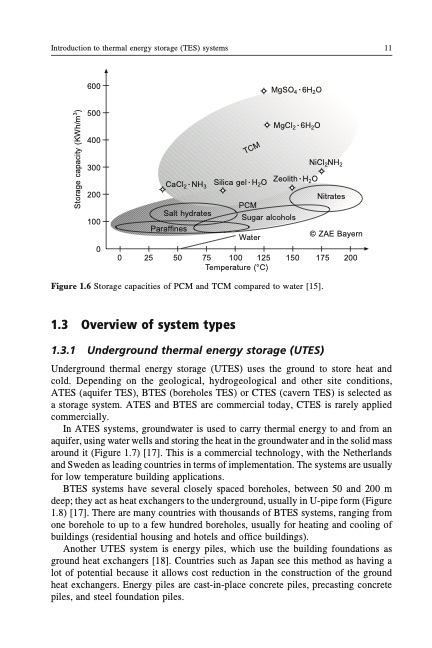
PDF Publication Title:
Text from PDF Page: 011
Introduction to thermal energy storage (TES) systems 11 600 500 400 300 200 100 CaCl2·NH3 Salt hydrates Paraffines Silica gel·H2O PCM MgSO4 · 6H2O MgCl2 · 6H2O NiCl2NH2 Zeolith·H2O Nitrates Sugar alcohols 0 0 25 50 75 100 125 150 175 200 Temperature (°C) Figure 1.6 Storage capacities of PCM and TCM compared to water [15]. 1.3 Overview of system types 1.3.1 Underground thermal energy storage (UTES) Underground thermal energy storage (UTES) uses the ground to store heat and cold. Depending on the geological, hydrogeological and other site conditions, ATES (aquifer TES), BTES (boreholes TES) or CTES (cavern TES) is selected as a storage system. ATES and BTES are commercial today, CTES is rarely applied commercially. In ATES systems, groundwater is used to carry thermal energy to and from an aquifer, using water wells and storing the heat in the groundwater and in the solid mass around it (Figure 1.7) [17]. This is a commercial technology, with the Netherlands and Sweden as leading countries in terms of implementation. The systems are usually for low temperature building applications. BTES systems have several closely spaced boreholes, between 50 and 200 m deep; they act as heat exchangers to the underground, usually in U-pipe form (Figure 1.8) [17]. There are many countries with thousands of BTES systems, ranging from one borehole to up to a few hundred boreholes, usually for heating and cooling of buildings (residential housing and hotels and office buildings). Another UTES system is energy piles, which use the building foundations as ground heat exchangers [18]. Countries such as Japan see this method as having a lot of potential because it allows cost reduction in the construction of the ground heat exchangers. Energy piles are cast-in-place concrete piles, precasting concrete piles, and steel foundation piles. Water © ZAE Bayern Storage capacity (KWh/m3) TCMPDF Image | Introduction to thermal energy storage TES systems

PDF Search Title:
Introduction to thermal energy storage TES systemsOriginal File Name Searched:
TES-introduction.pdfDIY PDF Search: Google It | Yahoo | Bing
Turbine and System Plans CAD CAM: Special for this month, any plans are $10,000 for complete Cad/Cam blueprints. License is for one build. Try before you buy a production license. More Info
Waste Heat Power Technology: Organic Rankine Cycle uses waste heat to make electricity, shaft horsepower and cooling. More Info
All Turbine and System Products: Infinity Turbine ORD systems, turbine generator sets, build plans and more to use your waste heat from 30C to 100C. More Info
CO2 Phase Change Demonstrator: CO2 goes supercritical at 30 C. This is a experimental platform which you can use to demonstrate phase change with low heat. Includes integration area for small CO2 turbine, static generator, and more. This can also be used for a GTL Gas to Liquids experimental platform. More Info
Introducing the Infinity Turbine Products Infinity Turbine develops and builds systems for making power from waste heat. It also is working on innovative strategies for storing, making, and deploying energy. More Info
Need Strategy? Use our Consulting and analyst services Infinity Turbine LLC is pleased to announce its consulting and analyst services. We have worked in the renewable energy industry as a researcher, developing sales and markets, along with may inventions and innovations. More Info
Made in USA with Global Energy Millennial Web Engine These pages were made with the Global Energy Web PDF Engine using Filemaker (Claris) software.
Sand Battery Sand and Paraffin for TES Thermo Energy Storage More Info
| CONTACT TEL: 608-238-6001 Email: greg@infinityturbine.com | RSS | AMP |